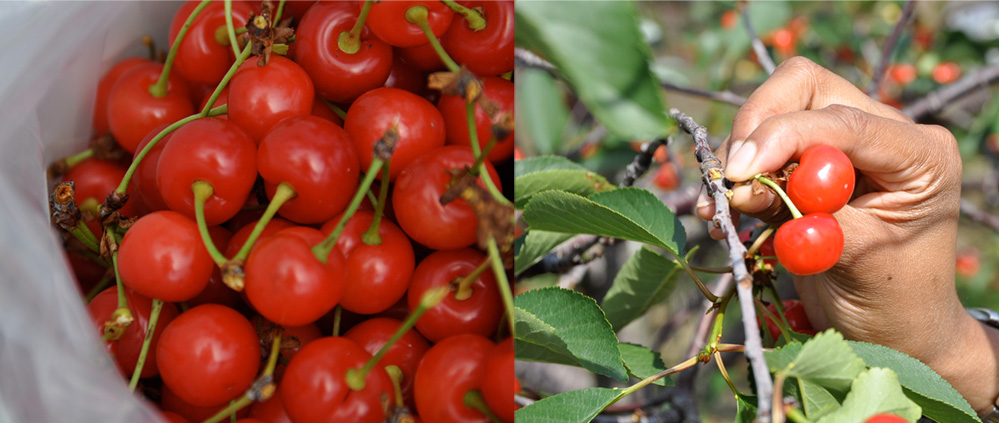You might have come across Melissa Clark’s recipe in the New York Times today for a luscious creme fraiche cheesecake served with a ruby-red, sour cherry compote. The decadent, creamy cheesecake certainly had me licking my lips, but I’ll be honest with you, it was those seductive gem-like orbs and their scarlet juices pooling sexily that really had me weak at the knees.
I don’t mean to be smug about it, but fortunately for me, I have a stash of sour cherries in the freezer just waiting to be caressed, simmered and bathed in sugar and balsamic vinegar as Clark prescribes. Assuming you don’t have sour cherry trees in your back yard, if you want to cook with sours there’s more prep work involved than with your average culinary project. You see, you can’t just go to the grocery store and pick up sour cherries (unless you know of a really special grocery store!), and they can even be tough to find at farmers’ markets. I know they’ve made only sporadic appearances at my local market in Manhattan’s Union Square. Their elusiveness is down to the fact that they are extremely temperamental creatures. They start to deteriorate almost immediately after they are picked making them a retailer’s nightmare. The vast majority of sour cherries grown in the US are carted straight from tree to factory where they are combined with more corn starch, sugar and corn syrup than you care to know about, and canned to make “pie filling.”
To cut to the chase, to get your hands on sour cherries you have to find someone who has an orchard and who is happy for you to come and fill up a large sack with their fruit. This is exactly what my husband and I did a few weeks ago at Terhune Orchards in Princeton, New Jersey. After a few hours of hard picking, we came home with about 17 pounds of sour cherries, 5 pounds of the most sublime Rainier cherries I have ever come across, and about $100 less in our pockets! We pitted the sours that day itself — you have to or they’ll spoil — and froze them in 2 pound quantities (just right for cherry pie), in ziplock bags. We’ve already made a couple of pies, and the rest will hopefully last us until we head back to the farm next year, or least until our bellies have had their fill of cherry-flavored confections.
Going cherry picking requires a little bit of forward planning and organization. But don’t worry, here’s everything you need to know.
Plan Ahead
Cherry season and especially sour cherry season is very short, a few weeks, or a month at best. It generally starts in the middle of June in New Jersey and New York, although it depends on the weather. You want to remember that sour cherry fanatics are relentless and they’ll pick a tree bare if they get the chance. This means that if you wait until the last weekend of the season, you’ll be stuck with all the dud fruit.
To find a farm, I like to use this fantastic website, www.pickyourown.org, that allows you to search for pick-your-own farms that are closest to you with searchable maps of individual states. (And this resource isn’t just for cherries, it’s for all pick-your-own fruits and vegetables.) Once you’ve selected your farm, you can go to their website, if they have one, and look on their calender for when they open up for cherry picking. But I also like to call up, just to be sure.
What to Take
Apart from your hat, good sturdy shoes, sun screen and plenty of water (it’ll be hot out!), you won’t need much. I like to take a large cooler bag to put my pickings in on the car ride home to keep my cherries cool, but this isn’t absolutely necessary as the farm will provide you with bags to put your fruit in once you check in upon arrival.
When to Go and What to do When You Get There
Get there as early as you can. If the farm opens its gates at 9am, get there as close to 9am as you can. Remember what I said about those cherry fanatics… Find the check in point, pay your deposit if you need to, and collect your bags and/or bucket. Now get a good sense of the lay of the land. Speak to someone who works on the farm and ask them which trees they think have the best fruit. Now this sounds silly, but some farms label the trees, some don’t, so make you you know which trees bear the type of cherries you’re after, whether it’ s golden Rainiers or Heidelfigens, red eating cherries (common varieties include Lapins, Somerset, Hartland, Ulster) or sours (Montmorency is probably the most popular variety). Sour cherries are the small, vibrant red colored ones — although their appearance can differ from one varietal to another.
How to Pick
Now that you’ve found your trees, lets get down to the nitty gritty. When picking cherries, always pick the fruit with the stem. If you pluck the cherry off of the stem, the fruit will spoil much more quickly since juice will leach out of the opening at the point where the stem was attached and the flesh will bruise and soften. To pick, select a unbruised, uncracked cherry, pinch the stem at the point where it meets the tree between your thumb and forefinger, then twist to release the stem and fruit away from the tree. Be careful not to overfill your bag or bucket so as not to squash the cherries at the bottom. If you come upon some high branches, find a ladder – there’ll be some around. Don’t climb the trees (unless you have permission), as you might break branches or damage the trees. And one more no-no — don’t eat as you pick. Sure, you can try the odd cherry to make sure you’re liking what you’re picking, but grazing consistently might get you thrown out.
Post Picking Prep
This is a very important step when it comes to sours — it could mean the difference between having to throw out all your hard work and having a steady supply of sour cherries through the winter. As soon as you get your sours home, give the cherries a gentle rinse in cold water to get rid of soil or dirt, then set out a couple of big bowls – one to house whole cherries, and one for the pitted cherries, and have a trash bag on hand for the stems and stones. Oh, and you might want to line your table with newspaper to avoid getting cherry juice all over it. Now, remove and discard the stems, and get pitting. To remove the stones you can buy a variety of mechanical pitters where you place the cherries in special indentations and metal rods stamp out the stones. If you don’t have one of these newfangled devices, try this novel method from Gourmet.com where you contort a paper clip into an “S” shape and use it to hook out the stones. If you try it, definitely let us know if it works. Make sure you collect any juices that try and escape during the pitting process. You might also want to save a few pits, as they can add a delicious almond flavor when you add them to a pan of simmering cherries – just remember to fish them out at the end, so no one bites down on one unexpectedly. Ouch!
Now that your cherries are beautifully stoned, divide them into portions, put them into ziplock bags with their juices, then write the date and the weight of the cherries on the bag and freeze. To use, simple remove the bag(s) from the freezer, and leave to defrost in a bowl in the fridge for a few hours or overnight.
If you also end up picking eating cherries, simply store them uncovered and unwashed in a bag in the coldest part of your fridge. When ready to eat, rinse them under cold water.

